Salivary Metabolic Profile of Patients with Lung Cancer, Chronic Obstructive Pulmonary Disease of Varying Severity and Their Comorbidity: A Preliminary Study
Abstract
1. Introduction
2. Materials and Methods
2.1. Study Design and Group Description
2.2. Collection, Processing, Storage and Analysis of Saliva Samples
2.3. Statistical Analysis
3. Results
3.1. Metabolic Features of Saliva in Lung Cancer Depending on the Presence/Absence of COPD
3.2. Influence of Histological Type of Lung Cancer on Metabolic Indicators of Saliva in Patients with COPD
3.3. Biochemical Markers of Saliva in Patients with Lung Cancer, Noncancerous Pathologies of the Lung and Control Group Depending on the Presence/Absence of COPD
3.4. Predictive Value of Saliva Biochemical Parameters Taking into Account the Presence/Absence of COPD
4. Discussion
5. Conclusions
Author Contributions
Funding
Conflicts of Interest
References
- Bray, F.; Ferlay, J.; Soerjomataram, I.; Siegel, R.L.; Torre, L.A.; Jemal, A. Global cancer statistics 2018: GLOBOCAN estimates of incidence and mortality worldwide for 36 cancers in 185 countries. CA Cancer J. Clin. 2018, 68, 394–424. [Google Scholar] [CrossRef] [PubMed]
- Siegel, R.L.; Miller, K.D.; Jemal, A. Cancer statistics. CA Cancer J. Clin. 2019, 69, 7–34. [Google Scholar] [CrossRef] [PubMed]
- Durham, A.L.; Adcock, I.M. The relationship between COPD and lung cancer. Lung Cancer 2015, 90, 121–127. [Google Scholar] [CrossRef] [PubMed]
- López-Campos, J.L.; Tan, W.; Soriano, J.B. Global burden of COPD. Respirology 2016, 21, 14–23. [Google Scholar] [CrossRef] [PubMed]
- Wang, Z. Association between chronic obstructive pulmonary disease and lung cancer: The missing link. Chin. Med. J. 2013, 126, 154–165. [Google Scholar] [PubMed]
- Young, R.P.; Hopkins, R.J.; Christmas, T.; Black, P.N.; Metcalf, P.; Gamble, G.D. COPD prevalence is increased in lung cancer, independent of age, sex and smoking history. Eur. Respir. J. 2009, 34, 380–386. [Google Scholar] [CrossRef] [PubMed]
- Mouronte-Roibás, C.; Leiro-Fernández, V.; Fernández-Villar, A.; Botana-Rial, M.; Ramos-Hernández, C.; Ruano-Ravina, A. COPD, emphysema and the onset of lung cancer. A systematic review. Cancer Lett. 2016, 382, 240–244. [Google Scholar] [CrossRef]
- Spyratos, D.; Papadaki, E.; Lampaki, S.; Kontakiotis, T. Chronic obstructive pulmonary disease in patients with lung cancer: Prevalence, impact and management challenges. Lung Cancer 2017, 8, 101–107. [Google Scholar] [CrossRef]
- Shvartsburd, P.M. Chronic inflammation increases the risk of developing epithelial neoplasms, inducing precancerous microenvironment: Analysis of the mechanisms of dysregulation. Vopr. Onkol. 2006, 52, 137. [Google Scholar]
- Hodge, S.J.; Hodge, G.L.; Reynolds, P.N.; Scicchitano, R.; Holmes, M. Increased production of TGF-β and apoptosis of T lymphocytes isolated from peripheral blood in COPD. Lung Cell Mol. Physiol. 2003, 285, 492–499. [Google Scholar] [CrossRef]
- Chen, X.; Dong, T.; Wei, X.; Yang, Z.; Pires, N.M.M.; Ren, J.; Jiang, Z. Electrochemical methods for detection of biomarkers of Chronic Obstructive Pulmonary Disease in serum and saliva. Biosens. Bioelectron. 2019, 142, 111453. [Google Scholar] [CrossRef] [PubMed]
- Agusti, A.; Gea, J.; Faner, R. Biomarkers, the control panel and personalized COPD medicine. Respirology 2016, 21, 24–33. [Google Scholar] [CrossRef] [PubMed]
- Eickmeier, O.; Huebner, M.; Herrmann, E.; Zissler, U.; Rosewich, M.; Baer, P.C.; Buhl, R.; Schmitt-Grohé, S.; Zielen, S.; Schubert, R. Sputum biomarker profiles in cystic fibrosis (CF) and chronic obstructive pulmonary disease (COPD) and association between pulmonary function. Cytokine 2010, 50, 152–157. [Google Scholar] [CrossRef]
- Wang, C.; Qian, L.; Ji, L.; Liu, S.; Wahid, A.; Jiang, X.; Sohail, A.; Ji, Y.; Zhang, Y.; Wang, P.; et al. Affinity chromatography assisted comprehensive phosphoproteomics analysis of human saliva for lung cancer. Anal. Chim. Acta 2020, 1111, 103–113. [Google Scholar] [CrossRef] [PubMed]
- Sun, Y.; Huo, C.; Qiao, Z.; Shang, Z.; Uzzaman, A.; Liu, S.; Jiang, X.; Fan, L.Y.; Ji, L.; Guan, X.; et al. Comparative proteomic analysis of exosomes and microvesicles in human saliva for lung cancer. J. Proteome Res. 2018, 17, 1101–1107. [Google Scholar] [CrossRef]
- Bel’skaya, L.V.; Sarf, E.A.; Kosenok, V.K.; Gundyrev, I.A. Biochemical Markers of Saliva in Lung Cancer: Diagnostic and Prognostic Perspectives. Diagnostics 2020, 10, 186. [Google Scholar] [CrossRef]
- Vestbo, J.; Hurd, S.S.; Agusti, A.G.; Jones, P.W.; Vogelmeier, C.; Anzueto, A.; Barnes, P.J.; Fabbri, L.M.; Martinez, F.J.; Nishimura, M.; et al. Global strategy for the diagnosis, management, andprevention of chronic obstructive pulmonary disease: GOLD executivesummary. Am. J. Respir. Crit. Care Med. 2013, 187, 347–365. [Google Scholar] [CrossRef]
- Lê, S.; Josse, J.; Husson, F. FactoMineR: An R Package for Multivariate Analysis. J. Stat. Softw. 2008, 25, 1–18. [Google Scholar] [CrossRef]
- Negrini, S.; Gorgoulis, V.G.; Halazonetis, T.D. Genomic instability—An evolving hallmark of cancer. Nat. Rev. Mol. Cell Biol. 2010, 11, 220–228. [Google Scholar] [CrossRef]
- Agusti, A.; Sin, D.D. Biomarkers in COPD. Clin. Chest Med. 2014, 35, 131–141. [Google Scholar] [CrossRef]
- Parimon, T.; Chien, J.W.; Bryson, C.L.; McDonell, M.B.; Udris, E.M.; Au, D.H. Inhaled corticosteroids and risk of lung cancer among patients with chronic obstructive pulmonary disease. Am. J. Respir. Crit. Care Med. 2007, 175, 712–719. [Google Scholar] [CrossRef] [PubMed]
- Hohberger, L.A.; Schroeder, D.R.; Bartholmai, B.J.; Yang, P.; Wendt, C.H.; Bitterman, P.B. Correlation of regional emphysema and lung cancer: A lung tissue research consortium-based study. J. Thorac. Oncol. 2014, 9, 639–645. [Google Scholar] [CrossRef] [PubMed]
- Hiraki, A.; Ueoka, H.; Takata, I.; Gemba, K.; Bessho, A.; Segawa, Y.; Kiura, K.; Eguchi, K.; Yoneda, T.; Tanimoto, M.; et al. Hypercalcemia—Leukocytosis syndrome associated with lung cancer. Lung Cancer 2004, 43, 301–307. [Google Scholar] [CrossRef] [PubMed]
- Hiraki, A.; Ueoka, H.; Bessho, A.; Segawa, Y.; Takigawa, N.; Kiura, K. Parathyroid hormone-related protein measured at first visit is an indicator for bone metastases and survival in lung cancer patients with hypercalcemia. Cancer 2002, 95, 1706–1712. [Google Scholar] [CrossRef] [PubMed]
- Reuter, S.; Gupta, S.C.; Chaturvedi, M.M.; Aggarwal, B.B. Oxidative stress, inflammation, and cancer: How are they linked? Free Radical Biol. Med. 2010, 49, 1603–1616. [Google Scholar] [CrossRef]
- Gȩgotek, A.; Nikliński, J.; Žarković, N.; Žarković, K.; Waeg, G.; Łuczaj, W.; Charkiewicz, R.; Skrzydlewska, E. Lipid mediators involved in the oxidative stress and antioxidant defense of human lung cancer cells. Redox Biol. 2016, 9, 210–219. [Google Scholar] [CrossRef]
- Barreiro, E.; Fermoselle, C.; Mateu-Jimenez, M.; Sánchez-Font, A.; Pijuan, L.; Gea, J.; Curull, V. Oxidative stress and inflammation in the normal airways and blood of patients with lung cancer and CORD. Free Radical Biol. Med. 2013, 65, 859–871. [Google Scholar] [CrossRef]
- Yigla, M.; Berkovich, Y.; Nagler, R.M. Oxidative stress indices in COPD—Broncho-alveolar lavage and salivary analysis. Arch. Oral Biol. 2007, 52, 36–43. [Google Scholar] [CrossRef]
- Pastor, M.D.; Nogal, A.; Molina-Pinelo, S.; Meléndez, R.; Salinas, A.; González De la Peña, M.; Martín-Juan, J.; Corral, J.; García-Carbonero, R.; Carnero, A.; et al. Identification of proteomic signatures associated with lung cancer and COPD. J. Proteom. 2013, 89, 227–237. [Google Scholar] [CrossRef]
- Bel’skaya, L.V.; Kosenok, V.K. The level of sialic acids and imidazole compounds in the saliva of patients with lung cancer of different histological types. Sib. J. Oncol. 2018, 17, 84–91. [Google Scholar] [CrossRef]
- Mészáros, B.; Járvás, G.; Farkas, A.; Szigeti, M.; Kovács, Z.; Kun, R.; Szabó, M.; Csánky, E.; Guttman, A. Comparative analysis of the human serum N-glycome in lung cancer, COPD and their comorbidity using capillary electrophoresis. J. Chromatogr. B 2020, 1137, 121913. [Google Scholar] [CrossRef] [PubMed]
- Bel’skaya, L.V.; Kosenok, V.K. The activity of metabolic enzymes in the saliva of lung cancer patients. Natl. J. Physiol. Pharm. Pharmacol. 2017, 7, 646–653. [Google Scholar] [CrossRef]
- Adamo, L.; Nassif, M.E.; Novak, E.; LaRue, S.J.; Mann, D.L. Prevalence of lactic acidaemia in patients with advanced heart failure and depressed cardiac output. Eur. J. Heart Fail. 2017, 19, 1027–1033. [Google Scholar] [CrossRef]
- Wheatley-Price, P.; Blackhall, F.; Lee, S.M.; Ma, C.; Ashcroft, L.; Jitlal, M.; Qian, W.; Hackshaw, A.; Rudd, R.; Booton, R.; et al. The influence of sex and histology on outcomes in non-small-cell lung cancer: A pooled analysis of five randomized trials. Ann. Oncol. 2010, 21, 2023–2028. [Google Scholar] [CrossRef] [PubMed]
- Sereno, M.; Esteban, I.R.; Zambrana, F.; Merino, M.; Gómez-Raposo, C.; López-Gómez, M.; Sáenz, E.C. Squamous-cell carcinoma of the lungs: Is it really so different? Crit. Rev. Oncol./Hematol. 2012, 84, 327–339. [Google Scholar] [CrossRef] [PubMed]
- Jeppesen, S.S.; Hansen, N.G.; Schytte, T.; Nielsenc, M.; Hansen, O. Comparison of survival of chronic obstructive pulmonary disease patients with or without a localized non-small cell lung cancer. Lung Cancer 2016, 100, 90–95. [Google Scholar] [CrossRef]
- Lange, P.; Marott, J.L.; Vestbo, J.; Olsen, K.R.; Ingebrigtsen, T.S.; Dahl, M.; Nordestgaard, B.G. Prediction of the clinical course of chronic obstructive pulmonary disease, using the new GOLD classification: A study of the general population. Am. J. Respir. Crit. Care Med. 2012, 186, 975–981. [Google Scholar] [CrossRef]
- Zhai, R.; Yu, X.; Shafer, A.; Wain, J.C.; Christiani, D.C. The impact of coexisting COPD on survival of patients with early-stage non-small cell lung cancer undergoing surgical resection. Chest 2014, 14, 346–353. [Google Scholar] [CrossRef]
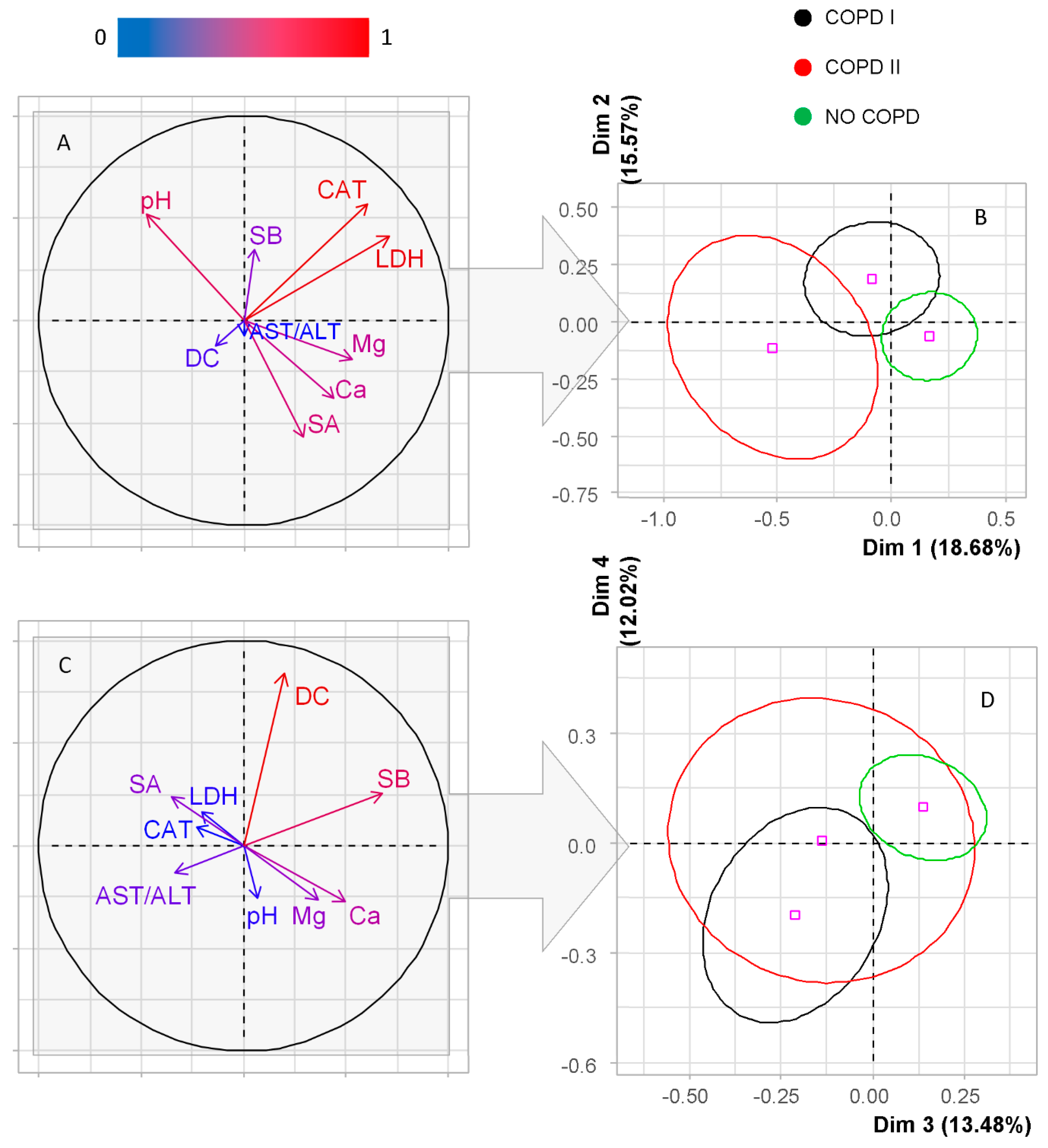
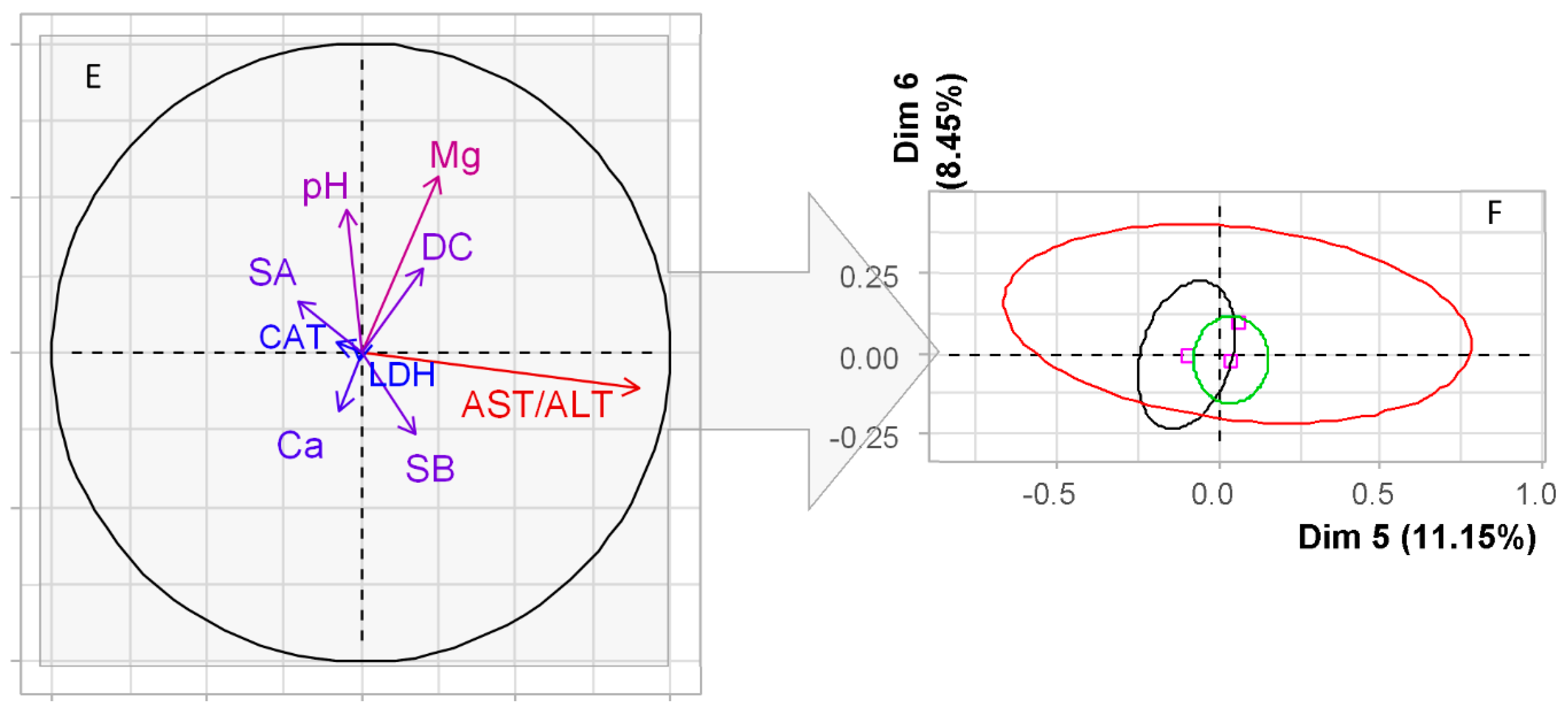
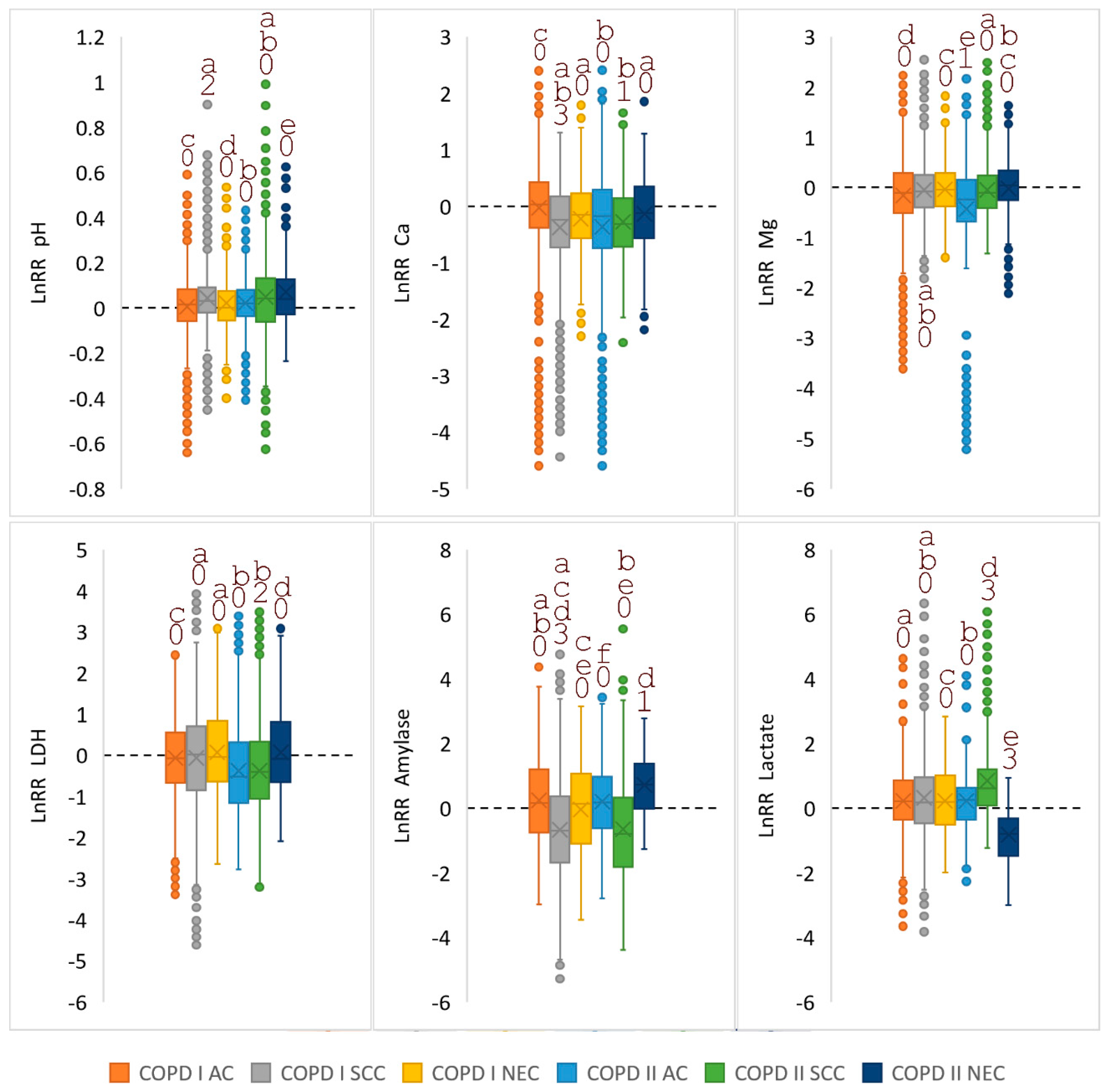
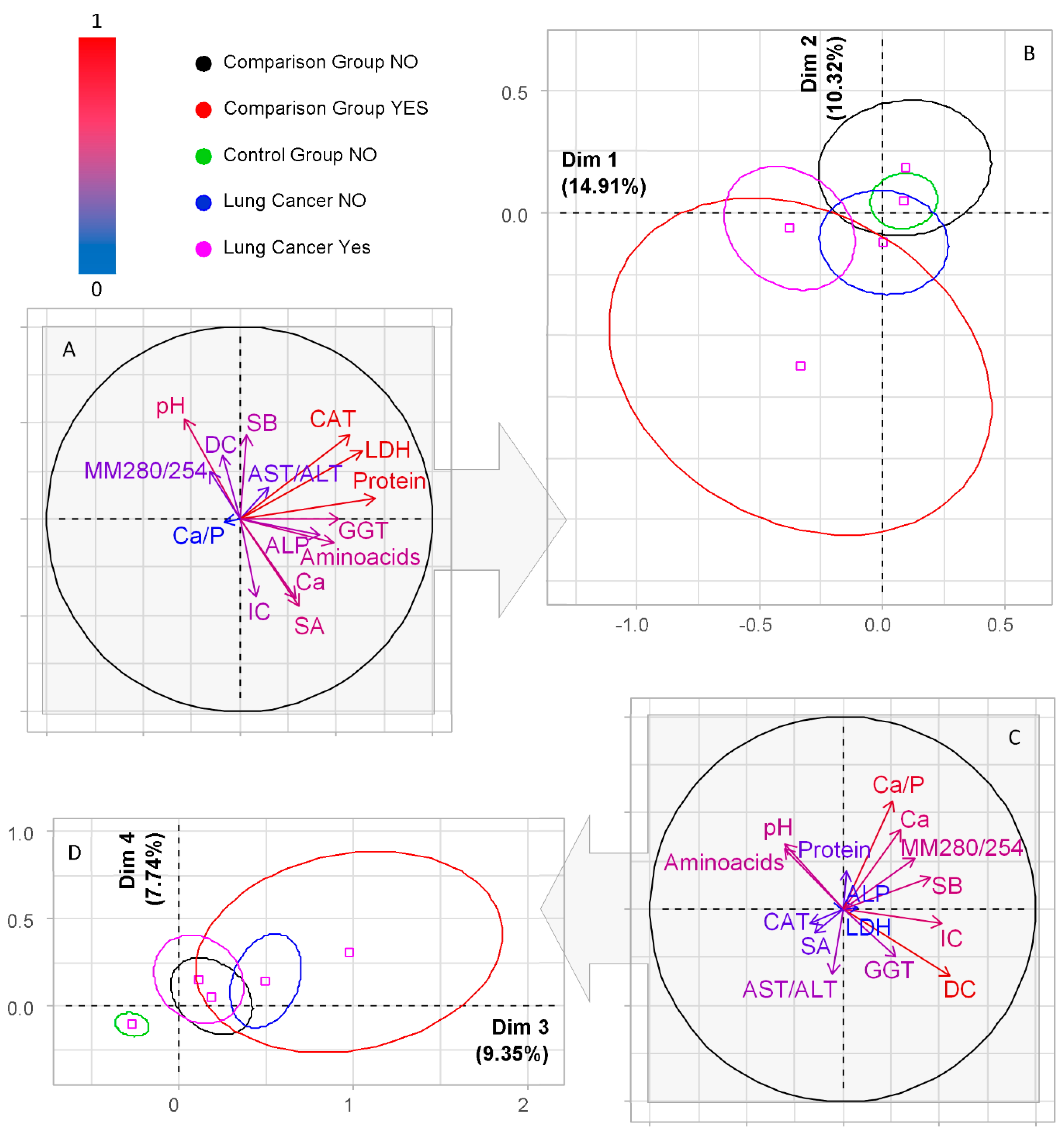
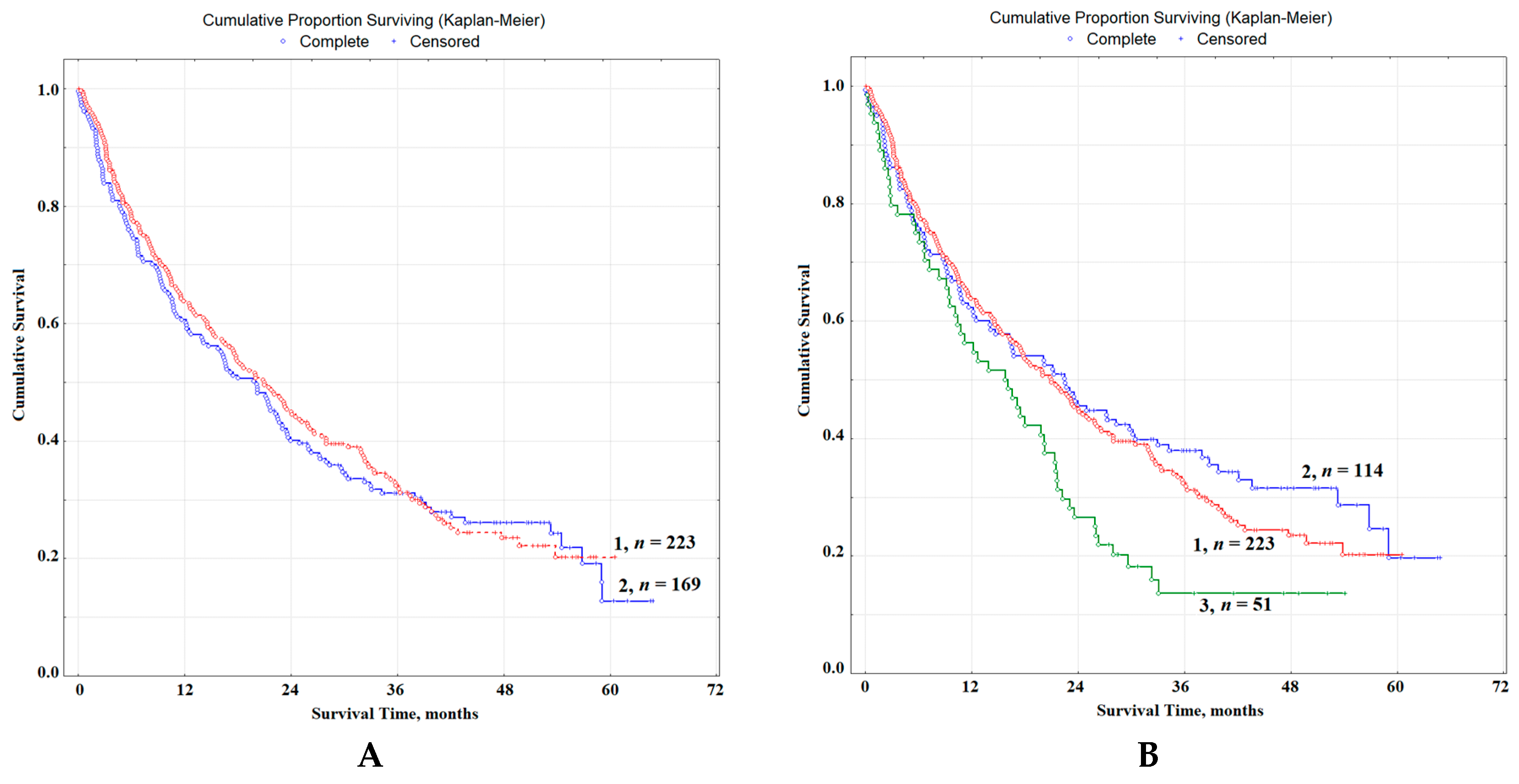

| Feature | Lung Cancer, n (%) | Non-Malignant Lung Diseases, n = 168 | ||||
|---|---|---|---|---|---|---|
| ADC, n = 189 | SCC, n = 135 | NEC, n = 68 | ||||
| Age, years | 61.0 (56.0; 65.0) | 59.0 (55.0; 66.5) | 55.0 (52.0; 60.0) | 55.0 (45.5; 60.5) | ||
| Gender | ||||||
| Male | 129 (68.3) | 128 (94.8) | 50 (73.5) | 98 (58.3) | ||
| Female | 60 (31.7) | 7 (5.2) | 18 (26.5) | 70 (41.7) | ||
| Stage | ||||||
| St IA | 16 (8.5) | 3 (2.2) | 5 (7.4) | - | ||
| St IB | 52 (27.5) | 28 (20.7) | 10 (14.7) | - | ||
| St IIA+B | 23 (12.2) | 19 (14.1) | 6 (8.8) | - | ||
| St IIIA | 25 (13.2) | 34 (25.2) | 10 (14.7) | - | ||
| St IIIB | 17 (9.0) | 24 (17.8) | 17 (25.0) | - | ||
| St IV | 56 (29.6) | 27 (20.0) | 20 (29.4) | - | ||
| COPD | ||||||
| No | 113 (59.8) | 69 (51.1) | 41 (60.3) | 141 (83.9) | ||
| Yes | GOLD I | 57 (30.2) | 40 (29.6) | 17 (25.0) | 27 (16.1) | |
| GOLD II | 18 (9.5) | 23 (17.1) | 10 (14.7) | - | ||
| GOLD III | 1 (0.5) | 3 (2.2) | - | - | ||
| Indicators | Lung Cancer (LC) | LC + COPD I | LC + COPD II | Kruskal-Wallis Test (H, p) | ||
|---|---|---|---|---|---|---|
| Flow rate, mL/min | 0.85 (0.72; 0.99) | 0.81 (0.74; 0.94) | 0.78 (0.64; 0.97) | ↓↓ | 0.8541, 0.7596 | |
| Electrolytes | ||||||
| pH | 6.46 (6.20; 6.68) | 6.57 (6.32; 6.85) | 6.63 (6.28; 7.03) | ↑↑ | 11.20, 0.0037 * | |
| Calcium (Ca), mmol/L | 1.48 (1.07; 1.92) | 1.41 (1.02; 1.80) | 1.19 (0.83; 1.51) | ↓↓ | 8.900, 0.0117 * | |
| Phosphorus (P), mmol/L | 4.61 (3.37; 5.78) | 4.00 (2.97; 5.32) | 4.55 (3.37; 6.01) | ↓↑ | 3.979, 0.1368 | |
| Ca/P-ratio, c.u. | 0.32 (0.23; 0.47) | 0.33 (0.23; 0.51) | 0.28 (0.17; 0.39) | =↑ | 4.737, 0.0936 ** | |
| Sodium (Na), mmol/L | 9.0 (5.4; 13.5) | 9.6 (6.1; 13.8) | 8.3 (5.9; 16.5) | ↑↓ | 0.9659, 0.6170 | |
| Potassium (K), mmol/L | 12.9 (9.4; 16.0) | 13.0 (8.5; 15.9) | 12.8 (9.3; 16.6) | == | 0.3176, 0.8532 | |
| Na/K-ratio, c.u. | 0.73 (0.45; 1.23) | 0.87 (0.48; 1.31) | 0.76 (0.46; 1.19) | ↑↓ | 1.058, 0.5892 | |
| Chlorides, mmol/L | 28.3 (22.3; 35.7) | 27.5 (21.0; 37.2) | 29.8 (21.0; 36.4) | ↓↑ | 0.1096, 0.9467 | |
| Magnesium, mmol/L | 0.311 (0.248; 0.381) | 0.286 (0.220; 0.361) | 0.279 (0.213; 0.346) | ↓↓ | 5.981, 0.0503 ** | |
| Protein Metabolism | ||||||
| Protein, g/L | 0.64 (0.33; 1.10) | 0.65 (0.36; 0.94) | 0.64 (0.40; 0.96) | == | 0.7507, 0.6870 | |
| Albumin, g/L | 0.313 (0.154; 0.475) | 0.286 (0.153; 0.462) | 0.311 (0.178; 0.485) | ↓↑ | 0.9102, 0.6344 | |
| Urea, mmol/L | 8.06 (5.34; 11.60) | 7.78 (6.09; 11.64) | 7.34 (4.49; 11.60) | ↓↓ | 0.4845, 0.7849 | |
| Uric acid, µmol/L | 90.4 (45.0; 181.0) | 76.7 (34.7; 133.7) | 100.0 (24.8; 195.2) | ↓↑ | 4.346, 0.1138 | |
| Sialic acids, mmol/L | 0.189 (0.110; 0.287) | 0.134 (0.079; 0.238) | 0.180 (0.093; 0.314) | ↓↑ | 6.161, 0.0459 * | |
| Seromucoids, c.u. | 0.104 (0.056; 0.159) | 0.097 (0.060; 0.149) | 0.081 (0.039; 0.134) | ↓↓ | 3.464, 0.1770 | |
| α-amino acids, µmol/L | 4.16 (3.87; 4.66) | 4.12 (3.86; 4.53) | 4.16 (3.93; 4.49) | ↓↑ | 0.5360, 0.7649 | |
| Imidazole compounds, mmol/L | 0.296 (0.197; 0.478) | 0.319 (0.182; 0.455) | 0.341 (0.266; 0.531) | ↑↑ | 1.995, 0.3688 | |
| Lactate, µmol/L | 2.32 (1.59; 3.50) | 2.75 (1.71; 3.96) | 3.12 (1.85; 4.14) | ↑↑ | 2.702, 0.2590 | |
| Enzymes | ||||||
| ALT, U/L | 4.00 (2.69; 6.00) | 3.77 (2.62; 4.96) | 4.15 (2.69; 6.54) | ↓↑ | 2.651, 0.2657 | |
| AST, U/L | 5.58 (3.33; 8.08) | 4.96 (3.25; 6.99) | 4.58 (3.04; 6.75) | ↓↓ | 3.854, 0.1456 | |
| AST/ALT, c.u. | 1.29 (1.01; 1.70) | 1.32 (1.03; 1.66) | 1.07 (0.86; 1.55) | ↑↓ | 5.026, 0.0810 ** | |
| ALP, U/L | 76.06 (49.98; 117.34) | 63.02 (47.81; 97.79) | 73.88 (52.15; 130.38) | ↓↑ | 2.284, 0.3192 | |
| LDH, U/L | 1248.5(604.3; 1907.0) | 1165.0(605.2; 1715.0) | 764.4(481.0; 1206.3) | ↓↓ | 9.210, 0.0100 * | |
| GGT, U/L | 22.3 (18.5; 26.1) | 20.6 (17.5; 25.5) | 21.1 (18.5; 23.1) | ↓↑ | 3.603, 0.1651 | |
| α-amylase, U/L | 317.4 (198.6; 655.7) | 287.6 (99.9; 600.9) | 303.3 (139.7; 680.2) | ↓↑ | 1.529, 0.4656 | |
| Catalase, ncat/mL | 2.66 (2.04; 4.36) | 2.78 (2.13; 4.13) | 2.41 (1.73; 3.17) | ↑↓ | 5.986, 0.0501 ** | |
| SOD, c.u. | 60.5 (26.3; 121.1) | 61.8 (34.2; 110.5) | 65.8 (39.5; 92.1) | ↑↑ | 0.1997, 0.9050 | |
| Lipoperoxidation products and endogenous intoxication rates | ||||||
| Diene conjugates, c.u. | 4.01 (3.83; 4.20) | 3.91 (3.75; 4.13) | 3.97 (3.79; 4.15) | 6.136, 0.0465 * | ||
| Triene conjugates, c.u. | 0.892 (0.775; 1.004) | 0.879 (0.792; 0.967) | 0.907 (0.793; 1.009) | ↓↑ | 0.7660, 0.6818 | |
| Schiff bases, c.u. | 0.561 (0.494; 0.675) | 0.529 (0.474; 0.638) | 0.556 (0.509; 0.652) | ↓↑ | 5.054, 0.0799 ** | |
| MDA, µmol/L | 7.14 (5.81; 9.32) | 6.67 (5.60; 9.27) | 8.46 (6.15; 10.17) | ↓↑ | 4.258, 0.1189 | |
| MM 280/254 nm | 0.897 (0.806; 1.002) | 0.875 (0.794; 0.989) | 0.906 (0.832; 1.055) | ↓↑ | 1.878, 0.3914 | |
| Indicator | HT | NO COPD | COPD I | COPD II | Kruskal-Wallis Test (H, p) |
|---|---|---|---|---|---|
| pH | ADC | 6.47 (6.22; 6.72) | 6.57 (6.32; 6.85) | 6.60 (6.29; 7.00) | 2.508, 0.2853 |
| SCC | 6.45 (6.23; 6.64) | 6.61 (6.43; 6.90) | 6.76 (6.13; 7.15) | 9.085, 0.0106 * | |
| NEC | 6.33 (6.03; 6.50) | 6.43 (6.14; 6.60) | 6.74 (6.28; 6.81) | 2.706, 0.2584 | |
| Calcium, mmol/L | ADC | 1.40 (1.03; 1.88) | 1.60 (1.11; 1.84) | 1.24 (0.77; 1.51) | 2.239, 0.3264 |
| SCC | 1.58 (1.14; 2.08) | 1.27 (0.85; 1.68) | 1.02 (0.83; 1.47) | 10.49, 0.0053 * | |
| NEC | 1.44 (1.28; 1.80) | 1.25 (1.03; 1.57) | 1.24 (0.98; 1.55) | 1.948, 0.3776 | |
| Magnesium, mmol/L | ADC | 0.320 (0.259; 0.406) | 0.285 (0.216; 0.389) | 0.245 (0.161; 0.343) | 5.441, 0.0658 ** |
| SCC | 0.302 (0.254; 0.378) | 0.292 (0.228; 0.336) | 0.277 (0.213; 0.349) | 2.117, 0.3471 | |
| NEC | 0.299 (0.230; 0.342) | 0.298 (0.219; 0.328) | 0.287 (0.275; 0.398) | 0.3195, 0.8524 | |
| AST/ALT, c.u. | ADC | 1.38 (1.01; 1.73) | 1.30 (1.08; 1.81) | 1.03 (0.76; 1.28) | 4.566, 0.1020 |
| SCC | 1.17 (0.92; 1.56) | 1.34 (1.01; 1.60) | 1.05 (0.94; 1.58) | 1.107, 0.5750 | |
| NEC | 1.31 (1.08; 1.69) | 1.34 (0.99; 1.88) | 1.32 (0.97; 1.54) | 0.3129, 0.8552 | |
| LDH, U/L | ADC | 1253.0 (655.1; 1842.0) | 1185.0 (665.7; 1647.0) | 572.3 (497.9; 1095.0) | 5.428, 0.0663 ** |
| SCC | 1193.0 (566.0; 1893.0) | 1205.5 (492.4; 1918.5) | 795.8 (437.7; 1108.0) | 3.955, 0.1384 | |
| NEC | 986.8 (446.5; 1940.0) | 1165.0 (1007.0; 1616.0) | 1148.0 (724.3; 1430.0) | 0.2333, 0.8899 | |
| Catalase, ncat/mL | ADC | 2.74 (2.12; 4.42) | 2.81 (2.18; 4.08) | 2.29 (1.81; 3.04) | 3.506, 0.1733 |
| SCC | 2.69 (2.00; 4.29) | 2.65 (2.12; 3.48) | 2.68 (1.90; 3.17) | 1.522, 0.4673 | |
| NEC | 2.36 (2.04; 3.38) | 3.48 (2.60; 4.33) | 1.72 (1.65; 3.24) | 3.137, 0.2083 | |
| Sialic acids, mmol/L | ADC | 0.159 (0.098; 0.275) | 0.125 (0.092; 0.226) | 0.168 (0.079; 0.323) | 2.103, 0.3493 |
| SCC | 0.201 (0.125; 0.281) | 0.150 (0.069; 0.269) | 0.183 (0.098; 0.232) | 3.468, 0.1766 | |
| NEC | 0.204 (0.101; 0.336) | 0.128 (0.092; 0.323) | 0.293 (0.092; 0.488) | 1.103, 0.5761 | |
| Diene conjugates, c.u. | ADC | 4.01 (3.83; 4.18) | 3.90 (3.67; 4.17) | 4.00 (3.79; 4.15) | 3.541, 0.1702 |
| SCC | 4.03 (3.85; 4.21) | 3.92 (3.78; 4.07) | 3.96 (3.78; 4.23) | 3.957, 0.1383 | |
| NEC | 4.05 (3.80; 4.15) | 3.99 (3.85; 4.16) | 3.88 (3.84; 3.92) | 1.135, 0.5669 | |
| Schiff bases, c.u. | ADC | 0.559 (0.499; 0.671) | 0.529 (0.478; 0.638) | 0.551 (0.495; 0.665) | 2.627, 0.2688 |
| SCC | 0.573 (0.490; 0.669) | 0.538 (0.476; 0.646) | 0.556 (0.507; 0.627) | 1.402, 0.4960 | |
| NEC | 0.557 (0.495; 0.641) | 0.487 (0.417; 0.633) | 0.570 (0.532; 0.662) | 1.589, 0.4517 | |
| α-amylase, U/L | ADC | 316.5 (178.7; 645.0) | 323.3 (184.7; 929.3) | 377.1 (266.5; 680.2) | 0.4174, 0.8116 |
| SCC | 270.7 (198.6; 857.0) | 232.3 (56.4; 360.3) | 232.8 (90.1; 284.7) | 6.986, 0.0304 * | |
| NEC | 349.6 (223.9; 458.8) | 477.1 (74.8; 965.0) | 796.8 (379.5; 1278.0) | 2.126, 0.3454 | |
| Lactate, nmol/mL | ADC | 2.14 (1.66; 3.12) | 2.75 (1.59; 4.41) | 3.12 (1.31; 3.43) | 1.032, 0.5971 |
| SCC | 2.23 (1.29; 3.36) | 2.74 (1.77; 3.96) | 4.14 (2.79; 4.74) | 2.887, 0.2361 | |
| NEC | 3.76 (2.68; 6.44) | 3.01 (2.28; 7.97) | 1.77 (0.76; 1.85) | 5.381, 0.0479 * |
| Indicator | Control Group | Lung Cancer | Comparison Group | Kruskal-Wallis Test (H, p) | ||
|---|---|---|---|---|---|---|
| Electrolytes | ||||||
| pH | 6.50 (6.30; 6.72) | 1 | 6.46 (6.20; 6.68) | 6.49 (6.24; 6.80) | 14.11, 0.0070 * | |
| 2 | 6.59 (6.32; 6.89) | 6.34 (6.08; 6.82) | ||||
| Calcium, mmol/L | 1.33 (1.05; 1.66) | 1 | 1.48 (1.07; 1.92) | 1.36 (1.02; 1.69) | 13.75, 0.0081 * | |
| 2 | 1.30 (0.97; 1.76) | 1.44 (1.16; 2.35) | ||||
| Phosphorus, mmol/L | 4.53 (3.58; 5.85) | 1 | 4.61 (3.37; 5.78) | 4.74 (3.47; 5.64) | 5.955, 0.2026 | |
| 2 | 4.13 (3.25; 5.53) | 4.80 (3.17; 6.54) | ||||
| Ca/P-ratio, c.u. | 0.29 (0.22; 0.39) | 1 | 0.32 (0.23; 0.47) | 0.29 (0.20; 0.40) | 11.34, 0.0230 * | |
| 2 | 0.31 (0.21; 0.47) | 0.34 (0.17; 0.53) | ||||
| Sodium, mmol/L | 8.4 (5.5; 12.4) | 1 | 9.0 (5.4; 13.5) | 7.8 (5.9; 10.7) | 5.546, 0.2357 | |
| 2 | 9.3 (6.1; 15.0) | 9.5 (4.8; 15.3) | ||||
| Potassium, mmol/L | 11.8 (9.3; 14.7) | 1 | 12.9 (9.4; 16.0) | 12.4 (9.4; 14.8) | 6.576, 0.1601 | |
| 2 | 12.8 (8.9; 15.9) | 9.7 (7.2; 13.9) | ||||
| Na/K-ratio, c.u. | 0.72 (0.49; 1.15) | 1 | 0.73 (0.45; 1.23) | 0.74 (0.47; 1.08) | 3.033, 0.5524 | |
| 2 | 0.83 (0.48; 1.30) | 0.90 (0.55; 1.49) | ||||
| Chlorides, mmol/L | 26.1 (21.2; 32.2) | 1 | 28.3 (22.3; 35.7) | 25.4 (20.7; 33.5) | 9.383, 0.0522 | |
| 2 | 28.2 (21.0; 36.8) | 23.3 (19.2; 34.3) | ||||
| Mg, mmol/L | 0.300 (0.246; 0.350) | 1 | 0.311 (0.248; 0.381) | 0.295 (0.241; 0.366) | 6.389, 0.1719 | |
| 2 | 0.286 (0.220; 0.349) | 0.313 (0.221; 0.400) | ||||
| Protein metabolism | ||||||
| Protein, g/L | 0.80 (0.50; 1.23) | 1 | 0.64 (0.33; 1.10) | 0.69 (0.49; 1.11) | 20.78, 0.0004 * | |
| 2 | 0.65 (0.36; 0.95) | 0.69 (0.54; 1.02) | ||||
| Albumin, g/L | 0.258 (0.171; 0.435) | 1 | 0.313 (0.154; 0.475) | 0.337 (0.178; 0.543) | 7.562, 0.1090 | |
| 2 | 0.295 (0.162; 0.474) | 0.304 (0.178; 0.498) | ||||
| Urea, mmol/L | 7.84 (5.40; 11.03) | 1 | 8.06 (5.34; 11.60) | 7.78 (5.27; 10.78) | 4.087, 0.3944 | |
| 2 | 7.57 (5.81; 11.60) | 6.12 (3.84; 9.06) | ||||
| Uric acid, µmol/L | 86.5 (28.2; 154.8) | 1 | 90.4 (45.0; 181.0) | 84.9 (30.4; 163.4) | 6.472, 0.1666 | |
| 2 | 80.4 (34.7; 146.8) | 85.0 (22.3; 176.6) | ||||
| Sialic acids, mmol/L | 0.195 (0.134; 0.299) | 1 | 0.189 (0.110; 0.287) | 0.165 (0.104; 0.238) | 35.35, 0.0000 * | |
| 2 | 0.146 (0.085; 0.262) | 0.134 (0.079; 0.201) | ||||
| Seromucoids, c.u. | 0.090 (0.060; 0.130) | 1 | 0.104 (0.056; 0.159) | 0.105 (0.066; 0.149) | 6.607, 0.1582 | |
| 2 | 0.092 (0.055; 0.141) | 0.095 (0.046; 0.146) | ||||
| α-amino acids, µmol/L | 4.12 (3.83; 4.50) | 1 | 4.16 (3.87; 4.66) | 4.25 (4.00; 4.60) | 13.05, 0.0110 * | |
| 2 | 4.13 (3.87; 4.51) | 4.02 (3.77; 4.50) | ||||
| Imidazole compounds, mmol/L | 0.281 (0.175; 0.379) | 1 | 0.296 (0.197; 0.478) | 0.326 (0.212; 0.448) | 30.09, 0.0000 * | |
| 2 | 0.326 (0.212; 0.478) | 0.448 (0.197; 0.660) | ||||
| Lactate, µmol/L | 2.36 (1.61; 3.48) | 1 | 2.32 (1.59; 3.50) | 2.65 (1.65; 3.24) | 3.357, 0.5000 | |
| 2 | 2.81 (1.77; 4.10) | 1.54 (0.36; 4.21) | ||||
| Enzymes | ||||||
| ALT, U/L | 3.62 (2.54; 4.92) | 1 | 4.00 (2.69; 6.00) | 3.96 (2.85; 6.31) | 13.56, 0.0088 * | |
| 2 | 3.88 (2.62; 5.38) | 3.58 (2.54; 5.23) | ||||
| AST, U/L | 5.50 (3.67; 7.33) | 1 | 5.58 (3.33; 8.08) | 6.00 (4.17; 8.67) | 12.22, 0.0158 * | |
| 2 | 4.92 (3.17; 6.99) | 4.29 (3.08; 6.75) | ||||
| AST/ALT, c.u. | 1.42 (1.13; 1.92) | 1 | 1.29 (1.01; 1.70) | 1.42 (1.08; 1.83) | 23.45, 0.0001 * | |
| 2 | 1.25 (0.97; 1.64) | 1.25 (1.00; 1.76) | ||||
| ALP, U/L | 58.7 (41.3; 82.6) | 1 | 76.1 (50.0; 117.3) | 71.7 (52.2; 115.2) | 38.57, 0.0000 * | |
| 2 | 69.5 (47.8; 108.7) | 69.5 (50.0; 117.3) | ||||
| LDH, U/L | 1127.5 (652.1; 1838.0) | 1 | 1248.5 (604.3; 1907.0) | 1291.0 (762.0; 1902.0) | 10.17, 0.0377 * | |
| 2 | 1060.0 (545.5; 1616.0) | 883.2 (527.7; 1443.0) | ||||
| GGT, U/L | 20.3 (17.5; 24.0) | 1 | 22.3 (18.5; 26.1) | 21.6 (18.1; 25.4) | 15.29, 0.0041 * | |
| 2 | 20.8 (18.0; 25.1) | 20.1 (16.2; 25.0) | ||||
| α-amylase, U/L | 201.6 (100.5; 404.4) | 1 | 317.4 (198.6; 655.7) | 316.0 (178.6; 468.4) | 23.54, 0.0001 * | |
| 2 | 287.6 (122.2; 618.1) | 168.1 (27.9; 804.2) | ||||
| Catalase, ncat/mL | 4.32 (3.20; 5.57) | 1 | 2.66 (2.04; 4.36) | 3.28 (2.34; 5.06) | 160.5, 0.0000 * | |
| 2 | 2.70 (1.97; 3.62) | 2.57 (1.76; 3.52) | ||||
| SOD, c.u. | 57.9 (34.2; 103.9) | 1 | 60.5 (26.3; 121.1) | 63.2 (42.1; 131.6) | 2.971, 0.5627 | |
| 2 | 63.2 (39.5; 110.5) | 63.2 (52.6; 84.2) | ||||
| Lipoperoxidation products and endogenous intoxication rates | ||||||
| Diene conjugates, c.u. | 3.92 (3.78; 4.06) | 1 | 4.01 (3.83; 4.20) | 3.97 (3.76; 4.13) | 21.50, 0.0003 * | |
| 2 | 3.92 (3.77; 4.14) | 4.04 (3.77; 4.25) | ||||
| Triene conjugates, c.u. | 0.870 (0.793; 0.944) | 1 | 0.892 (0.775; 1.004) | 0.901 (0.824; 1.010) | 7.994, 0.0918 | |
| 2 | 0.890 (0.792; 0.981) | 0.861 (0.792; 0.958) | ||||
| Schiff bases, c.u. | 0.528 (0.492; 0.565) | 1 | 0.561 (0.494; 0.675) | 0.555 (0.492; 0.686) | 38.33, 0.0000 * | |
| 2 | 0.541 (0.480; 0.640) | 0.563 (0.470; 0.661) | ||||
| MDA, µmol/L | 6.84 (5.81; 8.38) | 1 | 7.14 (5.81; 9.32) | 7.39 (5.94; 9.44) | 8.374, 0.0788 | |
| 2 | 7.35 (5.64; 9.91) | 6.03 (5.13; 9.10) | ||||
| MM 280/254 nm | 0.847 (0.749; 0.948) | 1 | 0.897 (0.806; 1.002) | 0.892 (0.812; 0.970) | 28.88, 0.0000 * | |
| 2 | 0.894 (0.802; 1.020) | 0.893 (0.776; 1.075) | ||||
Publisher’s Note: MDPI stays neutral with regard to jurisdictional claims in published maps and institutional affiliations. |
© 2020 by the authors. Licensee MDPI, Basel, Switzerland. This article is an open access article distributed under the terms and conditions of the Creative Commons Attribution (CC BY) license (http://creativecommons.org/licenses/by/4.0/).
Share and Cite
Bel’skaya, L.V.; Sarf, E.A.; Solomatin, D.V.; Kosenok, V.K. Salivary Metabolic Profile of Patients with Lung Cancer, Chronic Obstructive Pulmonary Disease of Varying Severity and Their Comorbidity: A Preliminary Study. Diagnostics 2020, 10, 1095. https://doi.org/10.3390/diagnostics10121095
Bel’skaya LV, Sarf EA, Solomatin DV, Kosenok VK. Salivary Metabolic Profile of Patients with Lung Cancer, Chronic Obstructive Pulmonary Disease of Varying Severity and Their Comorbidity: A Preliminary Study. Diagnostics. 2020; 10(12):1095. https://doi.org/10.3390/diagnostics10121095
Chicago/Turabian StyleBel’skaya, Lyudmila V., Elena A. Sarf, Denis V. Solomatin, and Victor K. Kosenok. 2020. "Salivary Metabolic Profile of Patients with Lung Cancer, Chronic Obstructive Pulmonary Disease of Varying Severity and Their Comorbidity: A Preliminary Study" Diagnostics 10, no. 12: 1095. https://doi.org/10.3390/diagnostics10121095
APA StyleBel’skaya, L. V., Sarf, E. A., Solomatin, D. V., & Kosenok, V. K. (2020). Salivary Metabolic Profile of Patients with Lung Cancer, Chronic Obstructive Pulmonary Disease of Varying Severity and Their Comorbidity: A Preliminary Study. Diagnostics, 10(12), 1095. https://doi.org/10.3390/diagnostics10121095






